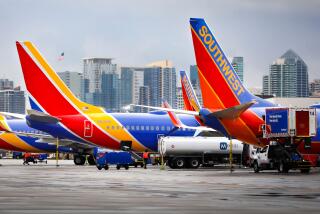Air Travelers’ Complaints Take a Quantum Leap
- Share via
Americans flew in record numbers last year and endured about the same rate of snafus--from delays to mishandled baggage to overbookings--as in the previous year. But they complained about the experiences in record numbers, new statistics show.
Consumers registered 17,381 complaints against U.S. airlines in 1999, according to the U.S. Department of Transportation (DOT), which collects figures from airlines and accepts comments from the public. That may not seem like many complaints, considering that 629 million passengers boarded U.S. and U.S.-originating foreign flights in 1999. But the number of complaints more than doubled, up from 7,980 in 1998.
New accessibility to the feds partly explains the increase. Until February 1998, travelers had to write a letter or make a toll call to the DOT, but now consumers can send their objections by e-mail. Since the introduction of e-mail, the number of these complaints has increased steadily, and they now make up about a quarter of all complaints registered, says Bill Mosley, a DOT spokesman. (Think how many complaints there might be if anyone installed a suggestion box at an airport.)
But as airline industry leaders have acknowledged, the boom in complaints also reflects a year of full planes and vociferous discontent with airline service.
Last summer, that widespread dissatisfaction led the U.S. Senate Commerce Committee to consider legislation aimed at making airlines more responsive to passengers. The committee and its chairman, Sen. John McCain (R-Ariz.), shelved the bill after the airlines devised a compromise: their own set of customer service plans, most of which took effect Dec. 15.
The airlines say these plans show their commitment to treating passengers better, from giving clear fare information to keeping travelers abreast of delays to compensating them for lost or damaged baggage. Many passenger complaints, industry veterans note, are byproducts of the airlines’ economic success in recent years; industry statistics show planes are flying with fewer empty seats than at any time since deregulation of the industry in the late 1970s. The 629 million passengers last year surpassed 1998’s record figure by 15 million, according to the Air Transport Assn., the Washington lobbying arm of the airline industry.
Because most of the customer service plans weren’t put in place until December, it will be months before changes do or don’t show up in the DOT’s consumer complaint tallies.
Here’s what the 1999 numbers show:
General consumer complaints: The most-maligned carrier was America West, with 697 complaints among 18.7 million passengers boarded, or 3.73 per 100,000. Second was the much larger American Airlines, with 2,848 complaints among 81.5 million passengers (3.50 per 100,000). The major carrier with the fewest complaints in 1999, as in 1998, was Southwest, with 259 complaints among 65.5 million passengers boarded, or 0.40 complaint for every 100,000 passengers.
Flight delays: Together, the 10 largest U.S. airlines arrived within 15 minutes of the scheduled time on 76.1% of their flights last year. Weather, airports, air traffic controllers, equipment, airline foul-ups and other factors caused the delays; the DOT numbers do not distinguish among the causes.
The tardiest carrier: America West, with a 69.5% on-time performance rate. The most prompt airline was TWA with an 80.9% on-time rate, just ahead of Southwest’s 80%.
At LAX, 81% of flights arrived on time last year. The flights most vulnerable to delays, no matter the airline, were scheduled between 4 and 5 p.m. and 8 and 10 p.m.
Mishandled baggage: Among the major carriers last year, about one in every 200 passengers filed a mishandled baggage report, a small improvement from 1998.
The airline most likely to lose customers’ bags in 1999, as in 1998, was United, the dominant carrier at LAX. In 1999 the carrier provoked 543,491 reports of mishandled baggage, about one for every 143 passengers.
United spokesman Matthew Triaca acknowledged that “we still do have a lot of work ahead of us” when it comes to baggage handling, and noted that United is in the middle of adding 500 high-tech baggage-scanning machines at LAX and other high-traffic airports. The airline with the fewest baggage complaints last year was United’s main competition on California routes, Southwest, which drew complaints from one in 237 passengers.
Bumped passengers: The final 1999 statistics on airline overbooking haven’t been compiled, but through September, DOT stats show that involuntary bumps were running ahead of 1998.
Airlines typically sell more seats than they have available, gambling that some buyers won’t show. If too many passengers appear, the carriers offer money to those who will accept later flights. If there aren’t enough volunteers, the carriers bump others involuntarily and offer up to $400 each.
In the first nine months of the year, the major carriers involuntarily bumped 0.95 passenger per 10,000 boarded (up from 0.84 in the first nine months of 1998). The leading bumper was Delta, which turned away 15,230 passengers involuntarily, or 1.98 per 10,000. Second most likely: Southwest, at 1.40 per 10,000 passengers. And the major airline least likely to involuntarily bump passengers: Northwest, with 0.20 passenger turned away per 10,000.
The DOT records complaints by phone at (202) 366-2220, by e-mail at airconsumer@ost.dot.gov and by conventional mail at U.S. Department of Transportation, C-75, Room 4107, Washington, DC 20590.
Christopher Reynolds welcomes comments, but cannot respond individually to letters and calls. Write Travel Insider, Los Angeles Times, Times Mirror Square, Los Angeles, CA 90053, or send e-mail to chris.reynolds@latimes.com.
Electronic Explorer
There seems to be a Web site for every kind of complaint. L19
More to Read
Sign up for The Wild
We’ll help you find the best places to hike, bike and run, as well as the perfect silent spots for meditation and yoga.
You may occasionally receive promotional content from the Los Angeles Times.







